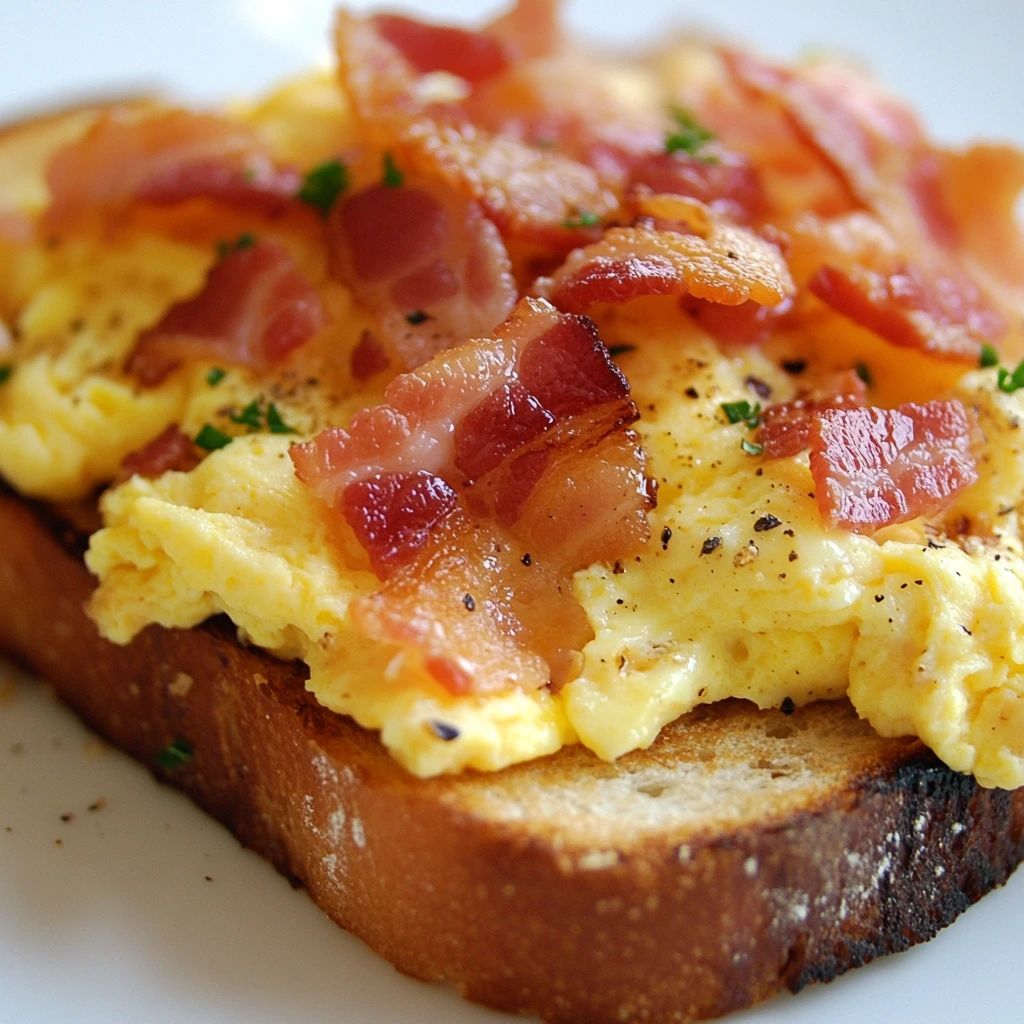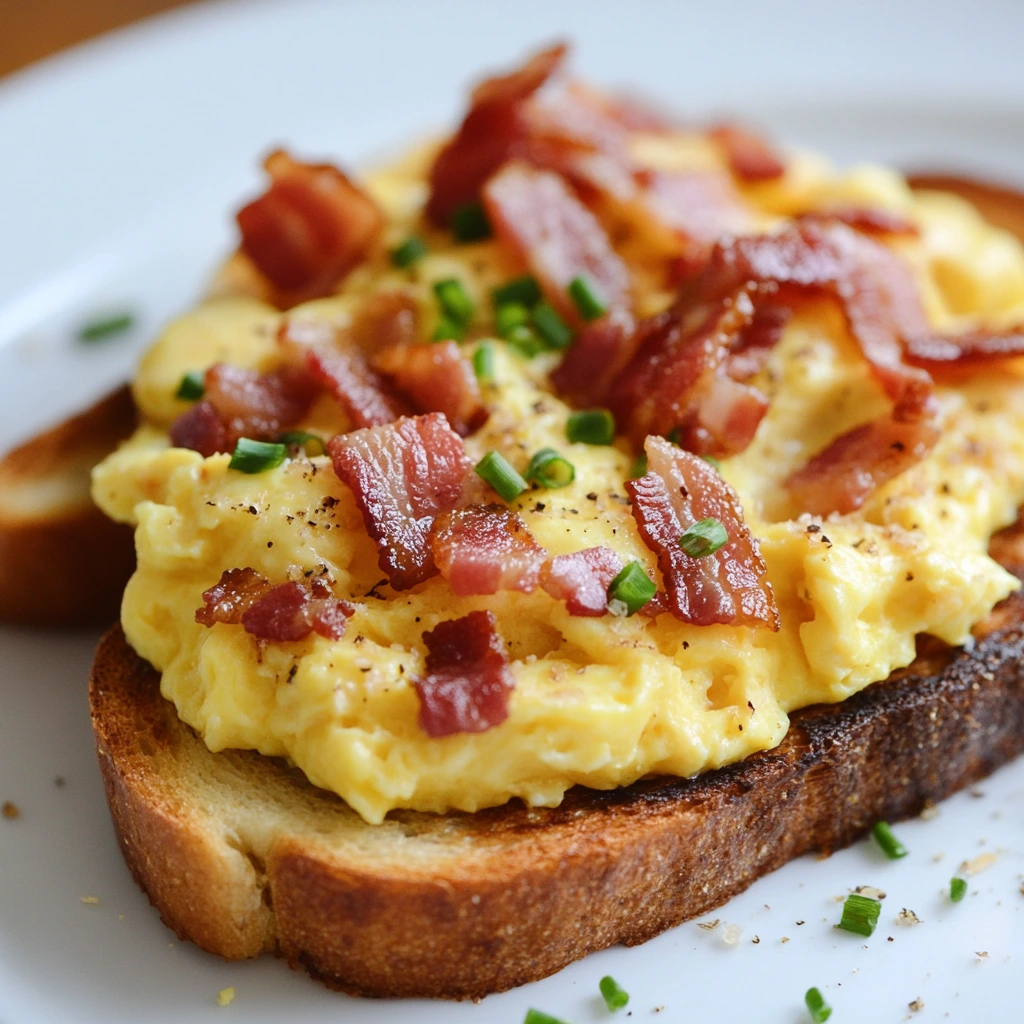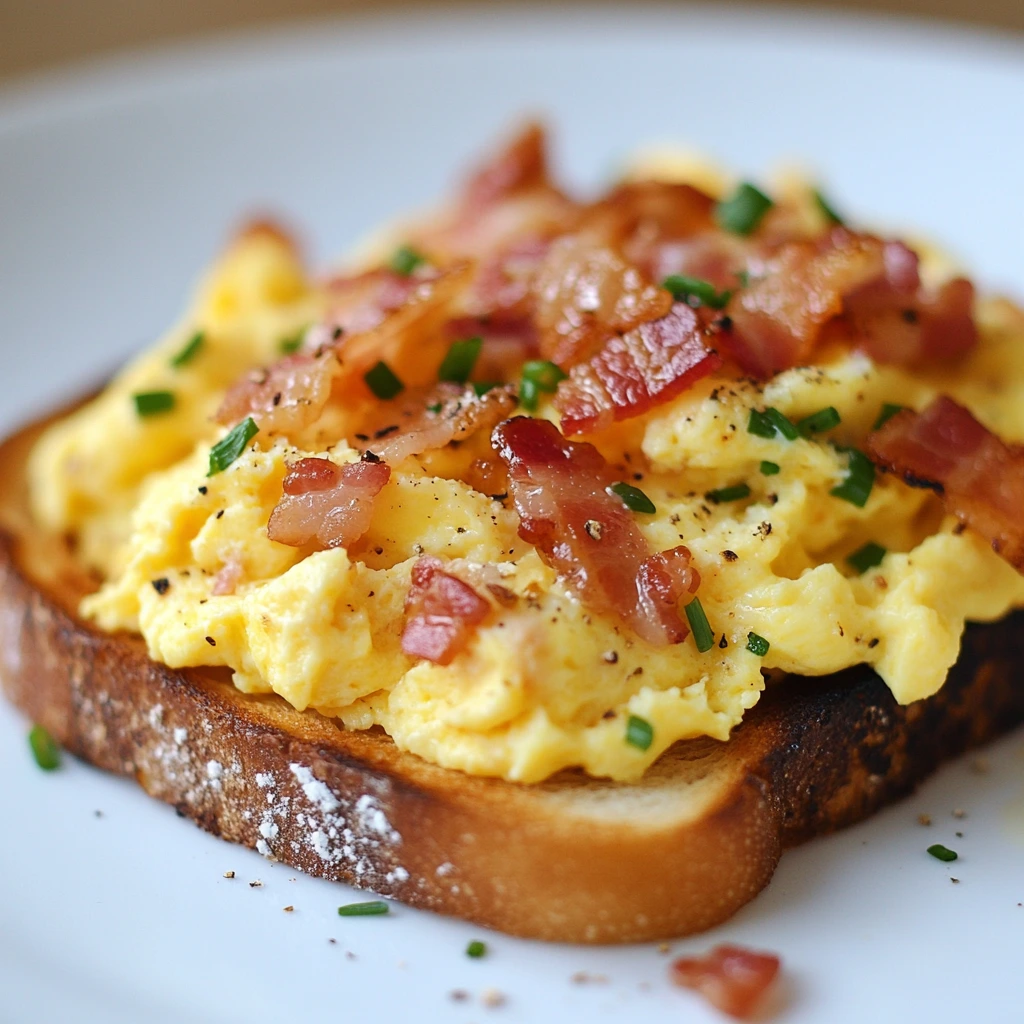Introduction
Overview of Scrambled Eggs & Bacon Toast
Scrambled eggs and bacon toast is a hearty, satisfying dish that has become a breakfast staple worldwide. The combination of creamy scrambled eggs, crispy bacon, and toasted bread offers a delightful blend of textures and flavors. This classic meal provides a comforting start to the day and is loved for its simplicity and versatility. Whether you prefer your eggs soft and fluffy or slightly firm, and your bacon crispy or chewy, scrambled eggs and bacon toast can be easily tailored to suit your taste.
As a quintessential breakfast dish, it is served in countless variations across different cultures. In some regions, the toast is piled high with scrambled eggs and bacon, while others add extra toppings like avocado, cheese, or fresh herbs for a unique twist. Its global appeal lies in its ability to adapt to local ingredients and preferences, making it a favorite for all ages.
Purpose of the Article
This article aims to provide a comprehensive guide to preparing scrambled eggs and bacon toast. From selecting the best ingredients to mastering the art of cooking the perfect eggs and bacon, we will cover every aspect of this beloved breakfast dish. Whether you’re a beginner in the kitchen or a seasoned chef, you’ll find valuable tips and techniques to elevate your scrambled eggs and bacon toast.
Additionally, we will explore the nutritional benefits of this dish, examining the role of protein, fats, and essential nutrients from the eggs, bacon, and toast. Plus, we will look at creative variations to inspire your cooking and help you make this meal your own. Whether you’re after a classic version or something with a modern twist, this guide has got you covered.
History and Origins
Historical Background
The origins of scrambled eggs and bacon can be traced back to separate culinary traditions, both of which date back centuries. Eggs, a versatile and easily accessible ingredient, have been part of human diets for thousands of years. Early recipes for scrambled eggs can be found in ancient Roman texts, though they were prepared quite differently from what we recognize today. Romans often cooked eggs in a mixture of oil or honey, creating a sweet, custard-like dish.
Bacon, on the other hand, has a long history as well, particularly in Western cuisine. The process of curing pork belly to make bacon dates back to ancient China, but it was the English and later the Americans who perfected the method of smoking and preserving it. By the Middle Ages, bacon had become a staple in Europe, celebrated for its rich, salty flavor and ability to store for extended periods.
The combination of scrambled eggs and bacon likely emerged in the 19th century, as cooking methods evolved and breakfast became an important meal. The pairing of eggs and bacon became popular in England and the United States, where it was often served alongside toast, a quick and easy way to add substance to the meal. Toast, a simple yet versatile component, played a key role in the dish’s evolution, offering a hearty base that complemented the eggs and bacon perfectly.
Cultural Significance
Scrambled eggs and bacon toast has since become a symbol of comfort food in many cultures. In the United States, it is a beloved breakfast dish often served in diners and homes alike. Its combination of protein-rich eggs, savory bacon, and warm toast provides both nutrition and satisfaction. The dish’s widespread popularity can be seen in its frequent appearance on breakfast menus around the world.
In the United Kingdom, the pairing of eggs and bacon has long been a part of the traditional English breakfast, often served alongside beans, tomatoes, and mushrooms. Similarly, in Australia and New Zealand, scrambled eggs and bacon are common breakfast items, often enjoyed with avocado or other local ingredients.
Globally, scrambled eggs and bacon toast holds its status as a comfort food because of its versatility and ability to evoke warmth and nostalgia. Whether enjoyed at a local café, a family breakfast table, or as a simple, quick meal at home, the dish remains a timeless favorite.
Nutritional Benefits
Nutritional Profile
Scrambled eggs and bacon toast offers a well-rounded meal, providing essential nutrients that contribute to a balanced breakfast. Let’s break down the nutritional content of each component:
- Scrambled Eggs: One large scrambled egg contains approximately 90 calories, 6 grams of protein, 7 grams of fat, and less than 1 gram of carbohydrates. Eggs are an excellent source of high-quality protein, which is essential for muscle growth and repair. They also contain healthy fats, including omega-3 fatty acids, and are rich in vitamins like B12, riboflavin, and vitamin D, all of which support energy production and overall health.
- Bacon: A typical slice of bacon contains about 42 calories, 3 grams of fat, and 3 grams of protein. Bacon is a source of fat-soluble vitamins, such as vitamin A and D, and provides minerals like zinc and iron, which help boost immune function and support blood health. However, it is also high in sodium and saturated fats, which can raise concerns for heart health when consumed in excess.
- Toast: A slice of whole wheat toast typically contains around 80-100 calories, 2-3 grams of protein, and 12-15 grams of carbohydrates, depending on the type of bread. Whole wheat bread adds fiber, B vitamins, and minerals like magnesium, all of which promote digestion, energy production, and heart health.
When combined, scrambled eggs, bacon, and toast create a meal that is high in protein and fats, along with moderate carbohydrates, making it a filling and energy-boosting breakfast.
Health Considerations
While scrambled eggs and bacon toast is a nourishing breakfast, it’s essential to consider certain health factors:
- Cholesterol Content: Eggs have earned a reputation for being high in cholesterol, which has led to debates about their impact on heart health. One large egg contains approximately 186 milligrams of cholesterol, all found in the yolk. However, recent research suggests that for most people, dietary cholesterol has minimal impact on blood cholesterol levels. The larger concern is the balance of fats in the diet, particularly saturated fats, which are more likely to raise cholesterol levels. For those with existing heart conditions, it might be wise to limit the yolk or opt for egg whites.
- Bacon Types: While traditional pork bacon is rich in flavor and texture, it is also high in saturated fats, sodium, and preservatives, which can raise concerns for heart health. A good alternative is turkey bacon, which is typically lower in fat and calories but still provides a similar savory taste. However, turkey bacon can sometimes be high in sodium as well, so choosing nitrate-free and lower-sodium options is crucial. For a healthier alternative, some people also opt for plant-based bacon, which is lower in fats and cholesterol and often made with soy or tempeh. Each type of bacon offers a different nutritional profile, so it’s important to make informed choices based on individual dietary needs.
By making mindful ingredient choices, you can enjoy scrambled eggs and bacon toast as part of a balanced, nutritious breakfast while managing your health concerns.
Preparation and Cooking Techniques
Selecting Ingredients
To create the perfect scrambled eggs and bacon toast, choosing the right ingredients is essential. Start with fresh, high-quality eggs. Opt for free-range or organic eggs if possible, as they tend to have richer yolks and more flavor. Look for eggs that have a firm shell and a vibrant yellow yolk, which indicates freshness. When it comes to bacon, select thick-cut, high-quality bacon for the best texture and flavor. You can choose between traditional pork bacon or leaner options like turkey bacon, depending on your dietary preferences.
For the toast, select a hearty bread that will hold up well to the eggs and bacon. Sourdough, whole grain, or rustic white bread are excellent choices. If you want a more indulgent option, consider brioche or challah for a rich, buttery flavor. Always choose bread that’s fresh to achieve the best texture when toasted. When sourcing ingredients, consider visiting local farmers’ markets or reputable grocery stores to find the freshest options, especially for eggs and bread.
Cooking Scrambled Eggs
The key to perfect scrambled eggs is cooking them slowly and gently. Start by cracking your eggs into a bowl, then whisk them with a fork or whisk until the yolks and whites are fully combined. For creamier eggs, add a tablespoon of milk or cream per egg. Season with a pinch of salt and pepper to taste.
In a non-stick skillet, melt a small amount of butter over low heat. Pour the beaten eggs into the pan and let them sit undisturbed for a few moments. As the edges begin to set, gently stir with a spatula, pushing the eggs from the edges toward the center. Continue stirring occasionally to ensure the eggs cook evenly. Remove the eggs from the heat while they’re still slightly runny—carryover cooking will finish them to perfection.
Common mistakes to avoid include cooking the eggs over high heat, which can make them dry and rubbery. Also, avoid over-stirring or constantly scrambling the eggs, as this can lead to a grainy texture. Patience is key—take your time for the fluffiest, most flavorful results.
Preparing Bacon
Achieving crispy bacon is all about cooking it at the right temperature. Start by laying your bacon strips in a cold pan, ensuring they don’t overlap. Turn the heat to medium and cook slowly, turning the strips occasionally until they reach the desired level of crispiness. This slow cooking method allows the fat to render out and results in perfectly crispy bacon.
Alternatively, you can bake bacon in the oven for an even, hands-off approach. Preheat the oven to 400°F (200°C) and lay the bacon on a baking sheet lined with parchment paper. Bake for 15-20 minutes, checking for crispiness. For an extra crispy result, you can place a cooling rack on top of the baking sheet, which allows the fat to drain away as the bacon cooks.
Grilling bacon is another great option, especially if you’re preparing a larger batch. Simply place the bacon on a grill over indirect heat, turning occasionally, until it becomes crispy and golden.
Toasting Bread
Achieving perfect toast is about balancing heat and time. For the best results, use a toaster or a skillet for even browning. If you prefer a toaster, adjust the setting for golden-brown toast, but keep an eye on it to avoid overcooking. For a skillet, heat a non-stick or cast-iron pan over medium heat, adding a small amount of butter or olive oil. Place the slices of bread in the pan and toast each side for 2-3 minutes or until golden brown.
If you’re using thicker slices of bread, like sourdough or brioche, you may want to toast it longer or even butter the bread before toasting to ensure a crisp, buttery finish. Try experimenting with different types of bread to change up the flavor profile, such as adding a drizzle of olive oil for a Mediterranean twist or using a whole grain option for a more rustic flavor.
Assembling the Dish
Assembling scrambled eggs, bacon, and toast is simple yet requires a little finesse for the perfect presentation. Begin by placing your toasted bread on the plate. Spoon a generous portion of scrambled eggs onto the toast, letting them spill slightly over the edges for a rustic look. Layer the crispy bacon over the eggs, ensuring the bacon doesn’t get soggy. For a touch of elegance, you can garnish with freshly chopped herbs, such as chives, parsley, or a sprinkle of black pepper.
For an added touch, consider drizzling a little olive oil or hot sauce over the eggs or adding a slice of avocado for extra creaminess. The key to a visually appealing plate is balance—ensure each component is evenly distributed and that the colors contrast beautifully. With these simple steps, you’ll have a dish that’s as pleasing to the eye as it is to the palate.
Variations and Serving Suggestions
Creative Variations
While scrambled eggs and bacon toast is a beloved classic, there are countless ways to put your own spin on the dish. Adding extra ingredients can elevate the flavors and textures, making the dish even more exciting. Here are some creative variations:
- Cheese Additions: A sprinkle of cheese can turn your scrambled eggs into a creamy, indulgent treat. Try adding shredded cheddar, feta, goat cheese, or parmesan for different flavor profiles. Soft cheeses like cream cheese or mascarpone can be folded directly into the eggs for extra creaminess.
- Herbs and Greens: Fresh herbs can bring a burst of flavor and color to your dish. Try folding in chives, parsley, basil, or thyme for a refreshing twist. You can also add a handful of spinach, arugula, or kale to the eggs, either cooked in or added fresh for a nutrient boost and a pop of color.
- Vegetable Boosts: Incorporating vegetables into your scrambled eggs and bacon toast is an excellent way to add texture and nutrition. Diced tomatoes, bell peppers, mushrooms, or onions can be sautéed and mixed into the eggs. For a more robust version, you can add roasted vegetables like zucchini or sweet potatoes for a heartier meal.
- Avocado or Guacamole: Add slices of ripe avocado or a dollop of guacamole for a creamy, rich element that pairs beautifully with the savory flavors of bacon and eggs. The creaminess balances the saltiness of the bacon and makes the toast even more satisfying.
International Twists on the Classic Dish
Scrambled eggs and bacon toast can be easily transformed with international flavors. Try these global twists to bring new life to this classic breakfast:
- Mexican-Inspired: Top your scrambled eggs with salsa, jalapeños, and cilantro for a zesty twist. Serve it with a side of black beans or a dollop of sour cream. You can also swap bacon for chorizo for a more authentic Mexican flair.
- Mediterranean Twist: Add crumbled feta cheese, olives, and a drizzle of olive oil to the eggs. Serve the toast with a side of fresh tomatoes, cucumber, and a sprinkle of oregano for a refreshing Mediterranean breakfast.
- British Version: For a hearty English breakfast, add grilled tomatoes, sautéed mushrooms, and a few slices of black pudding alongside the scrambled eggs and bacon. Swap out the toast for a thicker, buttered English muffin for added richness.
Serving Suggestions
To complete your scrambled eggs and bacon toast, pairing it with the right beverages and side dishes can enhance the overall meal experience.
- Beverages: Pair your breakfast with a warm, energizing beverage like freshly brewed coffee or tea. A strong espresso or cappuccino complements the richness of the eggs and bacon, while a herbal tea like chamomile or mint can provide a lighter contrast. Fresh juices, such as orange or grapefruit juice, add a refreshing and tangy note that balances the savory elements of the dish.
- Side Dishes: While scrambled eggs and bacon toast is filling on its own, adding a light side can round out the meal. Fresh fruit, such as a side of mixed berries or sliced melon, can provide a sweet contrast to the savory flavors. For a more indulgent option, serve with crispy hash browns, roasted potatoes, or even a small salad with a citrusy dressing. These sides can add variety and texture, enhancing the overall enjoyment of your breakfast.
With these creative variations and serving suggestions, scrambled eggs and bacon toast can be customized to suit any palate, making it a versatile and satisfying meal for any occasion.
FAQs
Is it healthy to eat scrambled eggs and bacon every day?
Eating scrambled eggs and bacon every day can be part of a healthy diet, but it depends on your overall nutrition and health goals. While eggs provide high-quality protein, essential vitamins, and healthy fats, bacon is high in saturated fats, sodium, and preservatives, which may raise concerns for heart health when consumed in excess. Eating this combination daily could lead to excessive sodium intake, which can contribute to high blood pressure and cardiovascular issues.
For most people, eating scrambled eggs and bacon a few times a week is perfectly fine as part of a balanced diet. However, if you have specific health conditions like high cholesterol or hypertension, it may be best to limit bacon and use healthier alternatives, such as turkey bacon or plant-based options. Moderation is key, and balancing this meal with a variety of nutrient-rich foods throughout the week can help maintain overall health.
Can I substitute bacon with other proteins?
Yes, there are several great alternatives to bacon that still provide a savory and satisfying element to your scrambled eggs and toast. Here are some options:
- Turkey Bacon: A leaner alternative to traditional pork bacon, turkey bacon offers similar texture and flavor but with less fat and fewer calories. It’s a great choice for those looking to reduce saturated fat intake while still enjoying the crispy crunch of bacon.
- Chicken Sausage: A flavorful and lower-fat option, chicken sausage pairs wonderfully with scrambled eggs and toast. Look for varieties with lower sodium and minimal additives.
- Plant-Based Bacon: For those following a vegetarian or vegan diet, plant-based bacon made from ingredients like soy, tempeh, or mushrooms offers a similar smoky, crispy texture without the meat. These alternatives are lower in fat and cholesterol-free.
- Lean Pork Bacon: If you still prefer traditional bacon, opt for leaner cuts of pork bacon, such as center-cut, which contain less fat than regular bacon but maintain a similar taste.
What type of bread is best for this dish?
The type of bread you choose can significantly impact the flavor and texture of your scrambled eggs and bacon toast. Here are some excellent bread options:
- Sourdough: With its tangy flavor and firm texture, sourdough bread is a popular choice. It holds up well to the richness of eggs and bacon and adds an extra layer of complexity to the dish.
- Whole Wheat: For a healthier option, whole wheat bread adds fiber, B vitamins, and minerals. Its slightly nutty flavor complements the savory eggs and bacon.
- Brioche: If you’re looking for something richer and sweeter, brioche is a great choice. Its buttery texture makes it perfect for absorbing the scrambled eggs and creating a luxurious mouthfeel.
- Rye Bread: Rye bread, with its distinctive flavor, pairs wonderfully with the saltiness of bacon. It’s a hearty, slightly tangy choice that adds depth to the meal.
How can I make this dish lower in fat?
There are several ways to reduce the fat content of scrambled eggs and bacon toast without sacrificing taste:
- Use Egg Whites or Egg Substitutes: Swap whole eggs for egg whites or egg substitutes to reduce the fat and cholesterol content. You’ll still get the protein without the extra fat from the yolk.
- Opt for Lean Bacon: Choose leaner bacon, such as turkey bacon or center-cut pork bacon, which are lower in fat than traditional bacon. You can also reduce the amount of bacon used or omit it entirely.
- Use Cooking Spray or Non-Stick Cookware: Instead of frying your eggs in butter or oil, use a small amount of cooking spray or a non-stick pan to cook the eggs. This will cut down on the added fats while still achieving a non-stick cooking surface.
- Add More Vegetables: Incorporating more vegetables, like spinach, mushrooms, or tomatoes, into the scrambled eggs can boost the nutritional value of the meal while keeping it lower in fat.
Can I prepare this dish in advance?
Yes, you can prepare components of scrambled eggs and bacon toast in advance to save time, especially if you are meal prepping. Here’s how:
- Scrambled Eggs: Scrambled eggs are best made fresh, but you can make them ahead of time and store them in an airtight container in the refrigerator for up to 2-3 days. Reheat gently in a pan over low heat to avoid overcooking.
- Bacon: Bacon can be cooked in bulk ahead of time and stored in the fridge for up to 5 days. Reheat it in the oven or microwave when ready to serve for a quick breakfast.
- Toast: Toasted bread can be prepared in advance and stored in a sealed bag for up to 2 days. Reheat it in a toaster or oven to bring back its crispiness.
For optimal meal prep, it’s best to store each component separately and assemble the dish when you’re ready to eat. This will keep the toast from becoming soggy and the eggs and bacon fresh.
Conclusion
Scrambled eggs and bacon toast is a timeless breakfast dish that combines simplicity, flavor, and versatility. Whether enjoyed in its classic form or with creative twists, it offers endless opportunities to suit every taste. From the richness of the eggs and bacon to the satisfying crunch of toast, this dish never fails to deliver. We encourage you to experiment with different ingredients, flavors, and textures to make it your own. Explore variations that reflect your culinary preferences and enjoy the delicious journey of crafting the perfect scrambled eggs and bacon toast.




